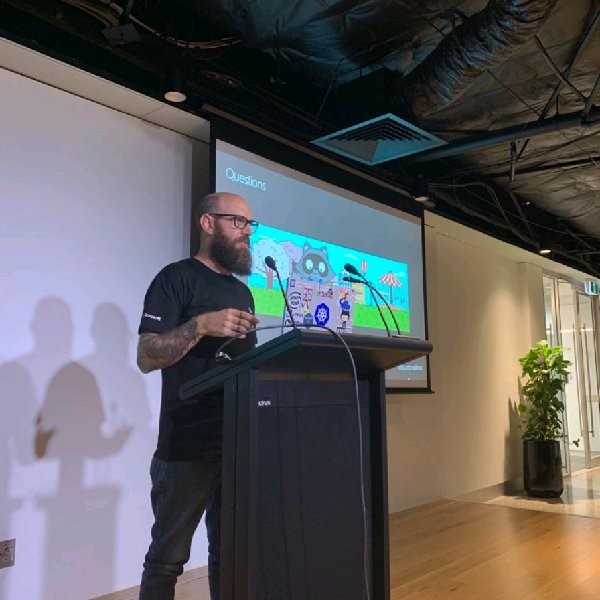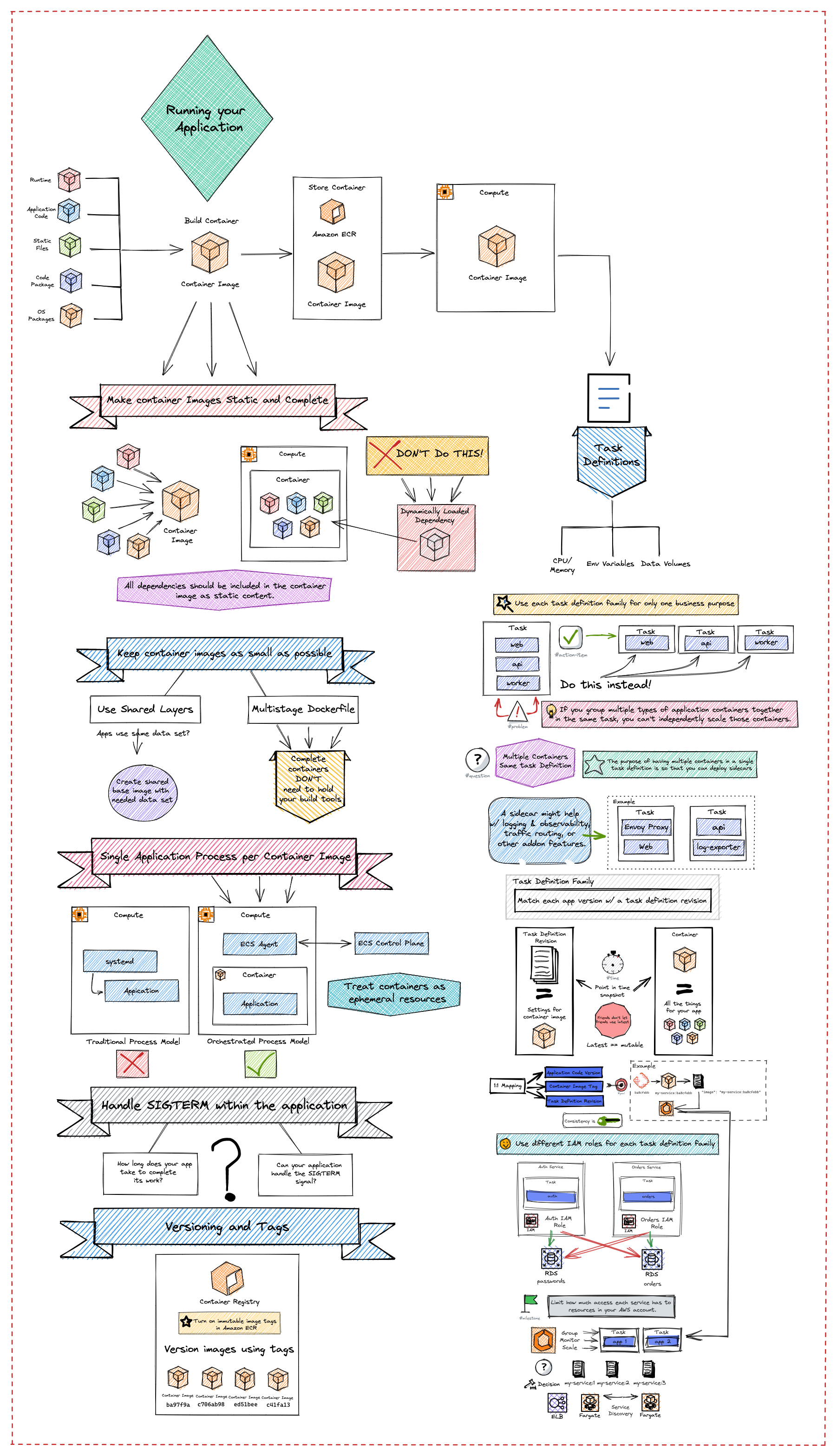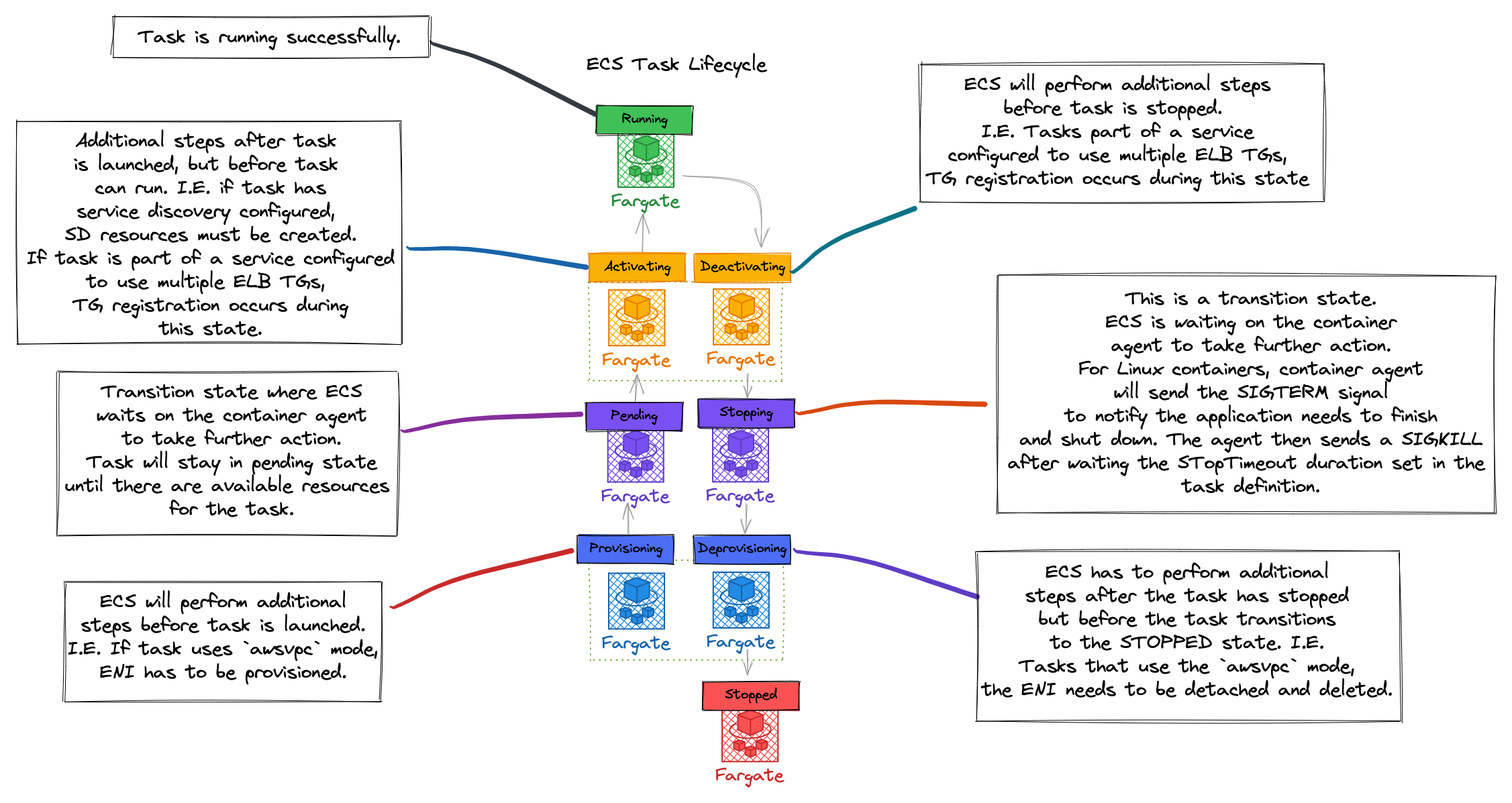Filters:
Blog Post
Getting Started with Amazon ECS and Bottlerocket
Bottlerocket is a Linux-based operating system optimized for hosting containers. It’s free and open-source software, developed in the open on GitHub. Bottlerocket is installed as the base operating system on the machine or instance where your containers themselves are running.
Getting Started with Amazon ECS and Bottlerocket
Blog Post
Getting Started with Amazon ECS and Amazon ECR
Amazon ECR eliminates the need to operate your own container repositories or worry about scaling the underlying infrastructure. Amazon ECR hosts your images in a highly available and scalable architecture, allowing you to reliably deploy containers for your applications.
Getting Started with Amazon ECS and Amazon ECR
Blog Post
Getting Started with Amazon ECS and CI/CD
Learn how to setup your first CI/CD pipeline using Amazon ECS, Amazon ECR, and AWS Developer Tools. CI/CD automates the application lifecycle, giving developers velocity and control over their containerized apps and services.
Getting Started with Amazon ECS and CI/CD
Blog Post
Getting Started with Amazon ECS and Amazon CloudWatch
Amazon ECS makes it easy to run and scale containerized workloads on AWS. Amazon CloudWatch lets you monitor running containers, the CPU and memory utilization of your containerized services, and setup alarms that automatically scale your services based on utilization.
Getting Started with Amazon ECS and Amazon CloudWatch
Blog Post
Getting Started with Amazon ECS and Load Balancers
Once you’re running containerized services on Amazon ECS, how do you get traffic to your containers to evenly distribute load and prevent dropped requests? Learn about how to setup Amazon ECS task definitions, configuring Target Groups, using the Application Load Balancer, and safely stopping services using task draining to make routing decisions and enable safe deployments for your containerized services in the following video:
Getting Started with Amazon ECS and Load Balancers
Blog Post
Getting Started with ECS and Autoscaling
Amazon Elastic Container Service (ECS) is a highly scalable, high performance container management service that supports industry-standard containers and allows you to easily run applications on a managed cluster of Amazon EC2 instances.
Getting Started with Amazon ECS and Autoscaling
Blog Post
Getting Started with Amazon ECS and Task Placement
Amazon Elastic Container Service (Amazon ECS) makes it easy to run and scale containerized workloads on AWS. The Amazon ECS task placement engine determines where tasks (logical groups of running containers) run.
Getting started with Amazon ECS and Task Placement
Blog Post
Cleaning up orphaned Amazon ECS container instances
I would like to share an interesting problem that came from some of our customers. This was an issue that they encountered with some of the EC2 instances in their ECS cluster.
A solution for dealing with orphaned EC2 nodes in your ECS cluster
Blog Post
Sparking joy in container host maintenance
I’m sure you can relate to this story: Step 1: You build the perfect application, … Step 3: you never think about it again. In the end, your team hands you a trophy and you get a massive raise for your efforts as well as the love/adoration of junior, senior, and executive colleagues.
A look at maintaining the host OS for container nodes
Blog Post
Using TLS certificates with Amazon ECS Service Connect
With this release, Amazon ECS integrates with AWS Private CA and automates the process of issuing, distributing, and rotating certificates, making it simple for customers to secure traffic between services without adding extra operational workload.
A post showing how to enable TLS on ECS services using Service Connect
Blog Post
Why use containers for your application?
Containers are a popular open source standard for developing, packaging, and operating applications at scale. There are a few key benefits to using containers: Packaging Containers provide you with a reliable way to gather your application components and package them together into one build artifact.
What are the benefits of packaging your application as a container?
Blog Post
Hello World
Well, well, well. Look what we have here. You have no idea how pleased I am to present to the world the newest resources for AWS Builders using Amazon Elastic Container services.
Welcome to Containers on AWS, the newest resource for AWS builders who want to deploy containerized applications on Amazon ECS
Blog Post
Hi I'm Nathan Peck! 👋
Hi! I work as a senior developer advocate at AWS. Prior to working at AWS I worked in the NYC startup scene, on my own personal projects, as well as Airtime (a social media platform focused on live social experiences), and StoryDesk (an iPad first presentation software with a built-in analytics system).
Meet AWS developer advocate Nathan Peck, and learn his thoughts on building with containers.
Blog Post
Hello friends, I'm Jessica!
Hi friends! My name is Jessica Deen and I’m currently a Principal Developer Advocate at AWS focusing on Amazon Elastic Container Service (Amazon ECS). Prior to joining AWS, I worked for Microsoft in a variety of capacitities for over a decade.
Meet Jessica Deen, developer advocate at AWS
Blog Post
EC2 or AWS Fargate?
There are two main compute options for running containers with Amazon Elastic Container Service: EC2 (Deploy and manage your own cluster of self managed virtual machine instances that can each run one or more containers) AWS Fargate (Run containers directly, without any virtual machines to think about) Both are completely valid techniques for operating your containers in a scalable and reliable fashion.
Comparison of Amazon EC2 and AWS Fargate across pricing, performance, and administrative overhead, with examples of best fits for each compute option.
Blog Post
Why should I use an orchestrator like Amazon ECS or Kubernetes?
If you work in software development for the cloud you have probably heard of infrastructure orchestrators such as Kubernetes, Amazon Elastic Container Service, or Hashicorp Nomad.
Does container orchestration make it easier to manage your application, or does it make it harder?
Blog Post
Optimize compute resources on Amazon ECS with Predictive Scaling
This blog is co-authored by Jooyoung Kim, Senior Containers Specialist Solutions Architect, Abhishek Nautiyal, Senior Product Manager, Amazon ECS and Ankur Sethi, Senior Product Manager, Amazon EC2. Introduction Amazon Elastic Container Service (Amazon ECS) is an opinionated, easy-to-use container orchestration service with deep AWS integrations that streamlines the deployment and management of containerized applications at […]
Read more...
Blog Post
Improving deployment visibility for Amazon ECS services
When deploying software, it’s critical to have visibility into all stages of the deployment process. Knowing the status of ongoing deployments, troubleshooting issues when things go wrong, and having an audit trail of past deployments are essential for ensuring a safe and reliable release process. Amazon Elastic Container Service (Amazon ECS) now provides enhanced observability […]
Read more...
Blog Post
How Infinitium reduced fraud detection time by 95% with Amazon ECS and AWS Fargate on AWS Graviton
This post was created in collaboration with Infinitium Engineering Team. Introduction Infinitium (a Euronet Company) is a leading digital payments company in Southeast Asia, specializing in secure online payment solutions and risk management services. With a strong presence across the Asia Pacific region, Infinitium offers cutting-edge technologies such as 3D Secure (3DS) authentication, fraud detection […]
Read more...
Blog Post
Serverless containers at AWS re:Invent 2024
AWS re:Invent is the premier learning conference hosted by AWS for the global cloud computing community. This year the Amazon Elastic Container Service (Amazon ECS) and AWS Fargate teams will share the latest trends, innovations, best practices, and tips to help you increase productivity, optimize costs, and enhance business agility. Join us in Las Vegas […]
Read more...
Blog Post
Migrating from AWS App Mesh to Amazon ECS Service Connect
After careful consideration, we have made the decision to discontinue AWS App Mesh, effective September 30th, 2026. Until this date, existing AWS App Mesh customers will be able to use the service as normal, including creating new resources and onboarding new accounts via the AWS CLI and AWS CloudFormation. Additionally, AWS will continue to provide […]
Read more...
Blog Post
Unlocking AWS Fargate feature for attaching Amazon EBS Volumes to ECS Tasks
Introduction Amazon Elastic Container Service (Amazon ECS) has now enhanced its functionalities by integrating support for Amazon Elastic Block Store (Amazon EBS) volume attachment to Amazon ECS tasks. This feature simplifies using Amazon ECS and AWS Fargate with Amazon EBS. Amazon ECS facilitates seamless provisioning and attachment of EBS volumes to ECS tasks on both […]
Read more...
Blog Post
Scale your Amazon ECS using different AWS native services!
Containers accelerate application development and enhance deployment consistency across environments, thus enabling organizations to improve productivity and agility. AWS container services such as Amazon Elastic Container Service (Amazon ECS) make it easier to manage your application so you can focus on innovation and your business needs. Customer experience is the most important yardstick by which […]
Read more...
Blog Post
Windows authentication with gMSA on Linux containers on Amazon ECS with AWS Fargate
Introduction Today, we are announcing the availability of Credentials Fetcher integration with AWS Fargate on Amazon Elastic Container Service (Amazon ECS). With this launch, you have the option of running Linux containers on Amazon ECS using both the Amazon Elastic Compute Cloud (Amazon EC2) launch type, as well as with AWS Fargate serverless compute launch […]
Read more...
Blog Post
Distributed machine learning with Amazon ECS
Running distributed machine learning (ML) workloads on Amazon Elastic Container Service (Amazon ECS) allows ML teams to focus on creating, training and deploying models, rather than spending time managing the container orchestration engine. With a simple architecture, control plane transparent upgrades, and native AWS Identity and Access Management (IAM) authentication, Amazon ECS provides a great environment […]
Read more...
Blog Post
How Perry Street Software Implemented Resilient Deployment Strategies with Amazon ECS
This post was coauthored by Ben Duffield and Eric Silverberg at Perry Street Software, with contributions from Adam Tucker, Piotr Wald, and Cristian Constantinescu of PSS. You just finished deploying that important change you spent weeks preparing, when you see this email subject in your inbox...
Read more...
Blog Post
Build preview environments for Amazon ECS applications with AWS Copilot
Introduction In the software development sphere, immediate evaluation of every code adjustment and deploying pull requests to active environments for immediate preview and feedback is essential. This practice is instrumental in reducing post-deployment issues and operational disruptions, underscoring the urgency for dedicated preview environments. Without these environments, the risk of merging unassessed features into the […]
Read more...
Blog Post
Secure Amazon Elastic Container Service workloads with Amazon ECS Service Connect
Introduction With this release, Amazon Elastic Container Service (Amazon ECS) integrates with AWS Private Certificate Authority (CA) and automates the process of issuing, distributing, and rotating certificates, which makes it simple for customers to secure traffic between services without adding extra operational workload. Now Amazon ECS Service Connect customers can encrypt service-to-service communication using Transport […]
Read more...
Blog Post
Amazon ECS enables easier EC2 capacity management, with managed instance draining
Amazon Elastic Container Service (ECS) deploys and manages your containerized tasks on AWS infrastructure. Customers can avoid the need to maintain compute instances by using Amazon ECS to deploy tasks on serverless AWS Fargate capacity. But some customers prefer to use Amazon ECS with Amazon Elastic Compute Cloud (Amazon EC2) as capacity. Using Amazon EC2 […]
Read more...
Blog Post
Effective use: Amazon ECS lifecycle events with Amazon CloudWatch logs insights
Introduction We have observed a growing adoption of container services among both startups and established companies. This trend is driven by the ease of deploying applications and migrating from on-premises environments to the cloud. One platform of choice for many of our customers is Amazon Elastic Container Service (Amazon ECS). The powerful simplicity of Amazon […]
Read more...
Blog Post
Run Monte Carlo simulations at scale with AWS Step Functions and AWS Fargate
Introduction Organizations across financial services and other industries have business processes that require executing the same business logic across billions of records for their machine learning and compliance needs. Many organizations rely on internal custom orchestration systems or big data frameworks to coordinate the parallel processing of their business logic across many parallel compute nodes. […]
Read more...
Blog Post
A deep dive into resilience and availability on Amazon Elastic Container Service
Introduction In this post, we’ll deep dive into the architecture principles we use in Amazon Elastic Container Service (Amazon ECS). We’ll outline some of the features that Amazon ECS delivers to make it easy for your application to achieve high availability and resilience. We explore how Amazon ECS is designed to use AWS availability and […]
Read more...
Blog Post
Use SMB storage with Windows containers on AWS Fargate
Introduction Customers can run their Windows container-based applications on Amazon Elastic Container Service (Amazon ECS) using AWS Fargate to avoid the undifferentiated heavy lifting of managing servers. A common use case for Windows Containers on AWS is to run web applications hosted using Internet Information Services (IIS). When using common files in a web farm, […]
Read more...
Blog Post
How Smartsheet optimized cost and performance with AWS Graviton and AWS Fargate
The post was co-written by Skylar Graika (Sr Principal Engineer, Smartsheet) Introduction Highly successful companies know that maintaining an accelerated pace of innovation is key to continued growth. They are increasingly looking to modernize their digital backbone of applications and development practices to support faster innovation and improved performance, security, and reliability, while maintaining a […]
Read more...
Blog Post
Build Generative AI apps on Amazon ECS for SageMaker JumpStart
Introduction The rise in popularity of Generative AI (GenAI) reflects a broader shift toward intelligent automation in the business landscape, which enables enterprises to innovate at an unprecedented scale, while adhering to dynamic market demands. While the promise of GenAI is exciting, the initial steps toward its adoption can be overwhelming. This post aims to […]
Read more...
Blog Post
Run Amazon EKS on RHEL Worker Nodes with IPVS Networking
Introduction Amazon Elastic Kubernetes Services (Amazon EKS) provides excellent abstraction from managing the Kubernetes control plane and data plane nodes that are responsible for operating and managing a cluster. AWS offers managed Amazon Machine Images, or AMIs, for Amazon Linux 2, Bottlerocket, and Windows Server. Many customers have requirements, or simply prefer, to use Red […]
Read more...
Blog Post
Migration considerations – Cloud Foundry to Amazon ECS with AWS Fargate
Introduction Customers often turn to Amazon Web Services (AWS) to scale their applications, reduce latency, and deploy new features quickly with pay as you go approach. Let’s take the case of customers running hundreds of applications using Cloud Foundry Platform as a Service (PaaS). To achieve cost efficiency, customers can migrate to AWS container services, […]
Read more...
Blog Post
Serverless containers at AWS re:Invent 2023
AWS re:Invent is the learning conference hosted by AWS for the global cloud computing community. This year the Amazon Elastic Container Service (Amazon ECS) and the AWS Fargate teams share their best practices and tips to help you increase productivity, optimize your costs, and amplify business agility. Join us in Las Vegas from November 27 […]
Read more...
Blog Post
Securing API endpoints using Amazon API Gateway and Amazon VPC Lattice
Introduction In microservices architectures, teams often build and manage internal applications that they expose as private API endpoints and publicly expose those endpoints through a centralized API gateway where security protections are centrally managed. These API endpoints allow both internal and external users to leverage the functionality of those applications. The separation of concerns between […]
Read more...
Blog Post
Run time sensitive workloads on ECS Fargate with clock accuracy tracking
Introduction In part 1 and part 2 of this series, the importance of measuring time accuracy and relevant concepts were discussed. Additionally, we covered specifics on ways to put those concepts into practice, track metrics using Amazon CloudWatch and implement a practical solution for Amazon Elastic Compute Cloud (Amazon EC2) instances. In this part 3, […]
Read more...
Blog Post
Scale to 15,000+ tasks in a single Amazon Elastic Container Service (ECS) cluster
Introduction Amazon Elastic Container Service (Amazon ECS) is a fully managed container orchestration service that simplifies your deployment, management, and scaling of containerized applications. Amazon ECS has deep AWS integrations and best practices built-in, which enable you to run and scale your applications in the cloud or on-premises, without the complexity of managing a control […]
Read more...
Blog Post
PBS speeds deployment and reduces costs with AWS Fargate
This blog post was co-authored by Mike Norton – VP Cloud Services & Operations, PBS, Warrick St. Jean – Sr. Director Solution Architect, PBS, and Brian Link – Director, Technical Operations, PBS Introduction PBS is a private, nonprofit corporation, founded in 1969, whose members are America’s public TV stations. They have been an AWS customer […]
Read more...
Blog Post
Start Spring Boot applications faster on AWS Fargate using SOCI
About a year ago, we published a post on how to Optimize your Spring Boot application for AWS Fargate, where we went into different optimization techniques to speed up the startup time of Spring Boot applications for AWS Fargate. We started the post with “Fast startup times are key to quickly react to disruptions and […]
Read more...
Blog Post
Build secure application networks with VPC Lattice, Amazon ECS, and AWS Lambda
Introduction In this post, we’ll explore how to publish and consume services running on Amazon Elastic Container Service (Amazon ECS) and AWS Lambda, as Amazon VPC Lattice services. For an introduction to Amazon VPC Lattice, please read the documentation here. One main reason customer experience a lower velocity of innovation, is the complexity they deal […]
Read more...
Blog Post
Improving operational visibility with AWS Fargate task retirement notifications
Introduction AWS Fargate, the serverless compute engine for containerized workloads, removes the undifferentiated heavy lifting of securing and patching the underlying infrastructure. In this blog post we dive into AWS Fargate task retirement, one of the ways AWS keeps the infrastructure secure and up to date. AWS has recently updated the AWS Fargate task retirement […]
Read more...
Blog Post
Multi-account infrastructure provisioning with AWS Control Tower and AWS Proton
Introduction The majority of the enterprise customers tend to establish centralize control and well-architected organization-wide policies when it comes to distribution of cloud resources in multiple teams. These teams are primarily divided into three categories - IT operations, Enterprise Security, and Application (App)-development. While delivery of business value from application standpoint falls under the purview of […]
Read more...
Blog Post
Announcing additional Linux controls for Amazon ECS tasks on AWS Fargate
Introduction An Amazon Elastic Container Service (Amazon ECS) task is a number of co-located containers that are scheduled on to AWS Fargate or an Amazon EC2 container instance. Containers use Linux namespaces to provide workload isolation—and with namespaces—even though containers are scheduled together in an Amazon ECS task, they’re still isolated from each other and […]
Read more...
Blog Post
Implement custom service discovery for Amazon ECS Anywhere tasks
Introduction Amazon Elastic Container Service (Amazon ECS) is a managed container orchestration service offered by AWS. It simplifies the deployment, management, and scalability of containerized applications using Amazon ECS task definitions through the AWS Management Console, AWS Command Line Interface (AWS CLI), or AWS Software Development Kits (AWS SDKs). Customers who require running containerized workloads, […]
Read more...
Blog Post
Preventing log loss with non-blocking mode in the AWSLogs container log driver
Introduction For improved observability and troubleshooting, it is recommended to ship container logs from the compute platform to a container running on to a centralized logging server. In the real world, the logging server may occasionally be unreachable or unable to accept logs. There is an architectural tradeoff when designing for log server failures. Service […]
Read more...
Blog Post
How RGC Genetics Center achieved infrastructure automation at scale using AWS Proton
This post was co-written with Rouel Lanche, Associate Director IT Architect, Regeneron Introduction Regeneron is a leading biotechnology company that invents, develops, and commercializes life-transforming medicines for people with serious diseases. Founded and led for 35 years by physician-scientists, Regeneron’s unique ability to repeatedly and consistently translate science into medicine has led to numerous FDA-approved […]
Read more...
Blog Post
Building better container images
Introduction Many applications built today or modernized from monoliths are done so using microservice architectures. The microservice architecture makes applications easier to scale and faster to develop, which enables innovation and accelerating time-to-market for new features. In addition, microservices also provide lifecycle autonomy enabling applications to have independent build and deploy processes, which provides technological […]
Read more...
Blog Post
Accelerate Amazon ECS-based workloads with ECS Blueprints
Introduction We are introducing ECS Blueprints for AWS Cloud Development Kit (AWS CDK) that makes it easier and faster to build container workloads for the Amazon Elastic Container Service (Amazon ECS). ECS Blueprints is a collection of Infrastructure as Code (IaC) open-source modules that help you configure and deploy container workloads on top of Amazon […]
Read more...
Blog Post
Implementing application load balancing of Amazon ECS Anywhere workloads using Traefik Proxy
Introduction With Amazon ECS Anywhere, you can run and manage containers on any customer-managed infrastructure using the same cloud-based, fully managed, and highly scalable container orchestration service you use in AWS today. Amazon ECS Anywhere provides support for registering an external instance, such as an on-premises server or virtual machine (VM), to your Amazon ECS […]
Read more...
Blog Post
Under the hood: Lazy Loading Container Images with Seekable OCI and AWS Fargate
AWS Fargate, a serverless compute engine for containerized workloads, now supports lazy loading container images that have been indexed using Seekable OCI (SOCI). Lazy loading container images with SOCI reduces the time taken to launch Amazon Elastic Container Service (Amazon ECS) Tasks on AWS Fargate. Donnie Prakoso’s launch post provides details on how to get […]
Read more...
Blog Post
Using Windows Authentication with gMSA on Linux Containers on Amazon ECS
On July 17th 2023, AWS launched support for Windows authentication with gMSA on non-domain-joined (domainless) Amazon ECS Linux container instances. This blog post has been updated to cover both modes, making domainless mode the default. Introduction Today, we are announcing the availability of Credentials Fetcher integration with Amazon Elastic Container Service (Amazon ECS). This […]
Read more...
Blog Post
Scaling IaC and CI/CD pipelines with Terraform, GitHub Actions, and AWS Proton
Introduction Modern applications run on a variety of compute platforms in AWS including serverless services such as AWS Lambda, AWS App Runner, and AWS Fargate. Organizations today are often required to support architectures using a variety of these AWS services, each offering unique runtime characteristics, such as concurrency and scaling, which can be purpose fit […]
Read more...
Blog Post
Announcing AWS Fault Injection Simulator new features for Amazon ECS workloads
Introduction We are happy to announce new features in AWS Fault Injection Simulator (FIS) that allow you to inject a variety faults into workloads running in Amazon Elastic Container Service (Amazon ECS) and Amazon Elastic Kubernetes Service (Amazon EKS). This blog shows how to use new AWS FIS actions with Amazon ECS. AWS Fault Injection […]
Read more...
Blog Post
Hosting Amazon Managed Workflows for Apache Airflow (MWAA) Local-runner on Amazon ECS Fargate for development and testing
Introduction Data scientists and engineers have made Apache Airflow a leading open-source tool to create data pipelines due to its active open-source community, familiar Python development as Directed Acyclic Graph (DAG) workflows, and an extensive library of pre-built integrations. Amazon Managed Workflows for Apache Airflow (MWAA) is a managed service for Apache Airflow that makes […]
Read more...
Blog Post
Improvements to Amazon ECS task launch behavior when tasks have prolonged shutdown
Amazon Elastic Container Service (Amazon ECS) now launches tasks faster on container instances that are running tasks that have a prolonged shutdown period. This enables customers to scale their workloads faster and improve infrastructure utilization. About Amazon ECS scheduling Amazon ECS is a container orchestrator that’s designed to be able to launch and track application […]
Read more...
Blog Post
Migrate cron jobs to event-driven architectures using Amazon Elastic Container Service and Amazon EventBridge
Introduction Many customers use traditional cron job schedulers in on-premise systems. They need a simple approach to move these scheduled tasks to AWS without refactoring while unlocking the scalability of the cloud. A lift-and-shift migration to Amazon Elastic Compute Cloud (Amazon EC2) is always a possibility, but that doesn’t take advantage of cloud-native services or […]
Read more...
Blog Post
How to establish private connectivity for ECS Anywhere
Introduction In 2014, AWS announced Amazon Elastic Container Service (Amazon ECS), a fully managed service that helps you orchestrate, deploy, and scale containerized applications. Although Amazon ECS serves a wide variety of customers from different segments, sizes, and verticals, there are cases where the applications need to run locally. For example, this often occurs in […]
Read more...
Blog Post
Implement Amazon ECS Anywhere enhanced workload resilience in disconnected scenarios
Introduction Amazon Elastic Container Service (ECS) Anywhere is a feature of Amazon ECS that lets you run and manage container workloads on your infrastructure. This feature helps you meet compliance requirements and scale your business without sacrificing your on-premises investments. When extending Amazon ECS to customer-managed infrastructure, external instances are registered to a managed Amazon […]
Read more...
Blog Post
Using Windows Authentication with gMSA on Linux Containers on Amazon ECS
Introduction Today, we are announcing the availability of Credentials Fetcher integration with Amazon Elastic Container Service (Amazon ECS). This integration makes it easier for developers to implement Windows Authentication in Linux containers running on Amazon ECS using Microsoft Active Directory (AD) group Managed Service Account (gMSA). The Credentials Fetcher daemon allows containers running on Linux […]
Read more...
Blog Post
Autoscaling Amazon ECS services based on custom metrics with Application Auto Scaling
Introduction Application Auto Scaling is a web service for developers and system administrators who need a solution for automatically scaling their scalable resources for AWS services such as Amazon Elastic Container Service (Amazon ECS) services, Amazon DynamoDB tables, AWS Lambda Provisioned Concurrency, and more. Application Auto Scaling now offers support for scaling such resources using […]
Read more...
Blog Post
Implementing a pub/sub architecture with AWS Copilot
Introduction The AWS Copilot CLI is a tool that since its launch in 2020, developers have been using to build, manage, and operate Linux and Windows containers on Amazon Elastic Container Service (Amazon ECS), AWS Fargate, and AWS App Runner. In this post, I’ll walk you through how you can use AWS Copilot CLI to […]
Read more...
Blog Post
Migrate existing Amazon ECS services from service discovery to Amazon ECS Service Connect
At re:Invent in November 2022 we announced a new Amazon Elastic Container Service (Amazon ECS) solution for service-to-service communication called Amazon ECS Service Connect. Amazon ECS Service Connect enables easy communication between microservices and across Amazon Virtual Private Clouds (Amazon VPCs) by leveraging AWS Cloud Map namespaces and logical service names. This allows you to […]
Read more...
Blog Post
Announcing Amazon ECS Task Definition Deletion
Today, we are happy to announce new functionality in Amazon Elastic Container Services (Amazon ECS) that allows you to delete task definition revisions. Until now, you were only able to deregister a task definition revision and it would no longer display in your ListTaskDefinition API calls or in your Amazon ECS console, unless you specifically […]
Read more...
Blog Post
Kubernetes as a platform vs. Kubernetes as an API
Introduction What is Kubernetes? I have been working on this technology since the beginning and after 8 years, I’m still having a problem defining what it is. Some people define Kubernetes as a container orchestrator but does that definition capture the essence of Kubernetes? I don’t think so. In this post, I’d like to explore […]
Read more...
Blog Post
Architecture evolution: From zero to future-proof architecture at home24
This blog was co-authored by Aurelijus Banelis, Senior Software Engineer at home24 Introduction Home24 is a leading pure-play home & living e-commerce platform in continental Europe and Brazil. It has third-party and private-label assortments combined with a tailored user experience — and that is a good foundation for a sustainable technology business. Aurelijus is proud […]
Read more...
Blog Post
Configuring KMS encryption at rest on ECR repositories with ECR replication
Introduction In this blog post, you’ll learn how to configure AWS Key Management Service (AWS KMS) at rest on Amazon Elastic Container Registry (Amazon ECR) with image replication. By default, repository settings aren’t replicated, and with the information contained in this article, we’ll empower your organization to put security first while using the AWS tools […]
Read more...
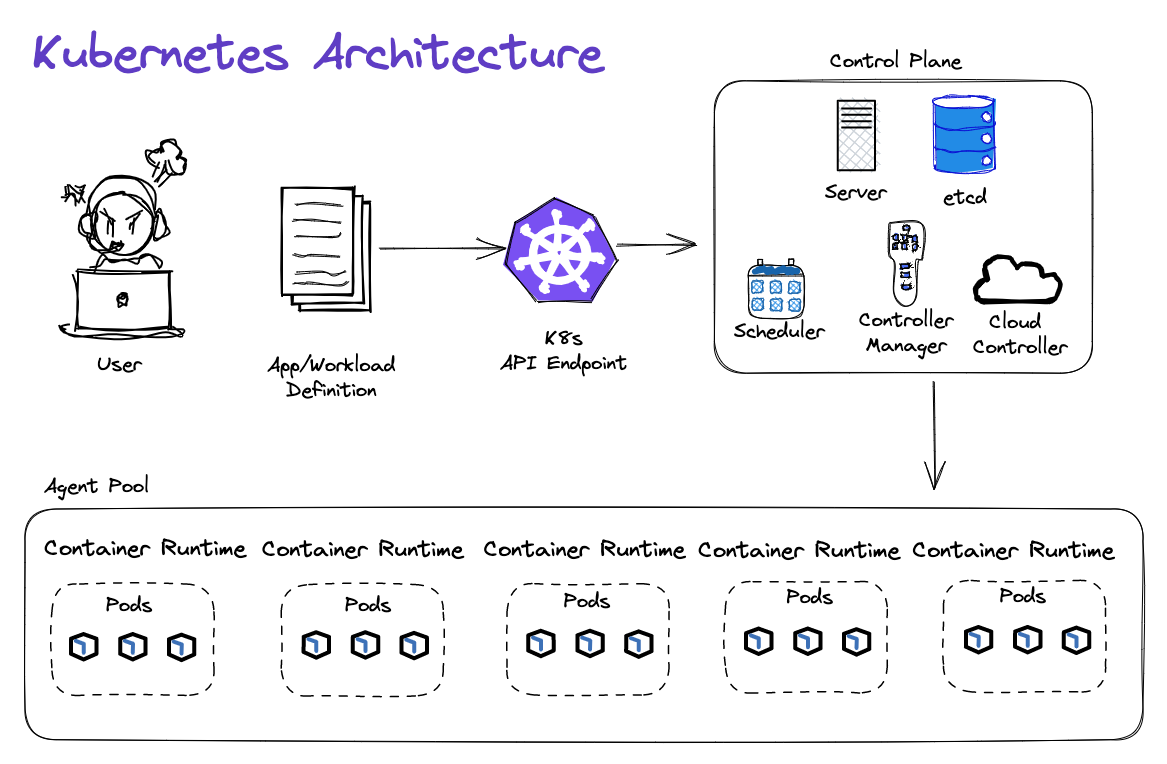
Kubernetes Architecture
Amazon Elastic Kubernetes Service (Amazon EKS) is a managed Kubernetes service to run Kubernetes in the AWS cloud and on-premises data centers. In the cloud, Amazon EKS automatically manages the availability and scalability of the Kubernetes control plane nodes responsible for scheduling containers, managing application availability, storing cluster data, and other key tasks.
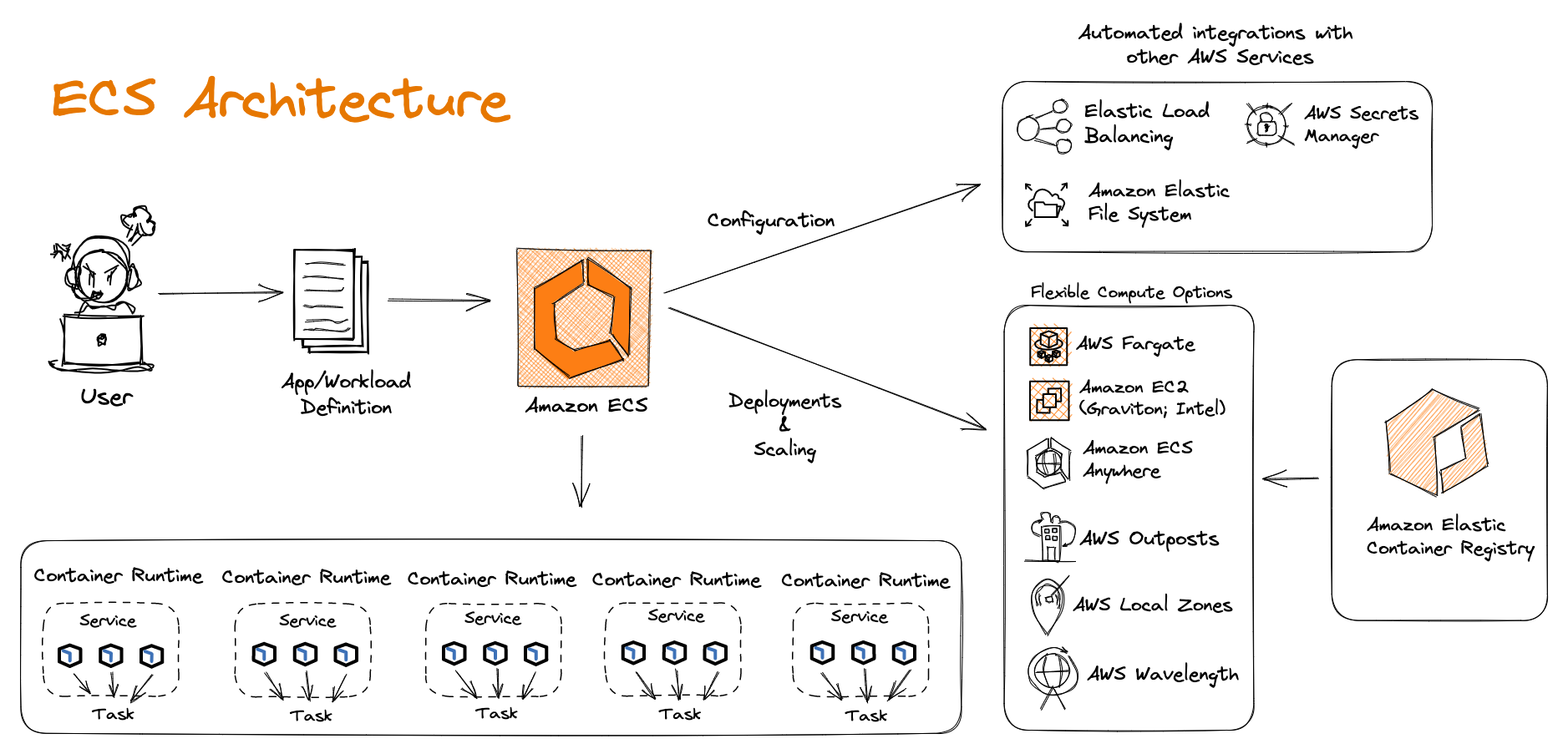
Amazon ECS Architecture
Amazon Elastic Container Service (Amazon ECS) is a fully managed container orchestration service that simplifies your deployment, management, and scaling of containerized applications. Simply describe your application and the resources required, and Amazon ECS will launch, monitor, and scale your application across flexible compute options with automatic integrations to other supporting AWS services that your application needs.












